
AP bio chapter 5 study note
concept 5.1 cellular membranes are fluid mosaics of lipids and proteins
lipids and proteins are essential to the membranes → carbohydrates too
most abundant lipids are phospholipids
able to form membranes because of their molecular structure
amphipathic (hydrophilic and hydrophobic regions)
a phospholipid bilayer (the actual lipid itself) can be made as a stable boundary between 2 aqueous compartments
the molecular arrangement protects the hydrophobic tail from interacting with the liquid and the hydrophilic head exposed to the water
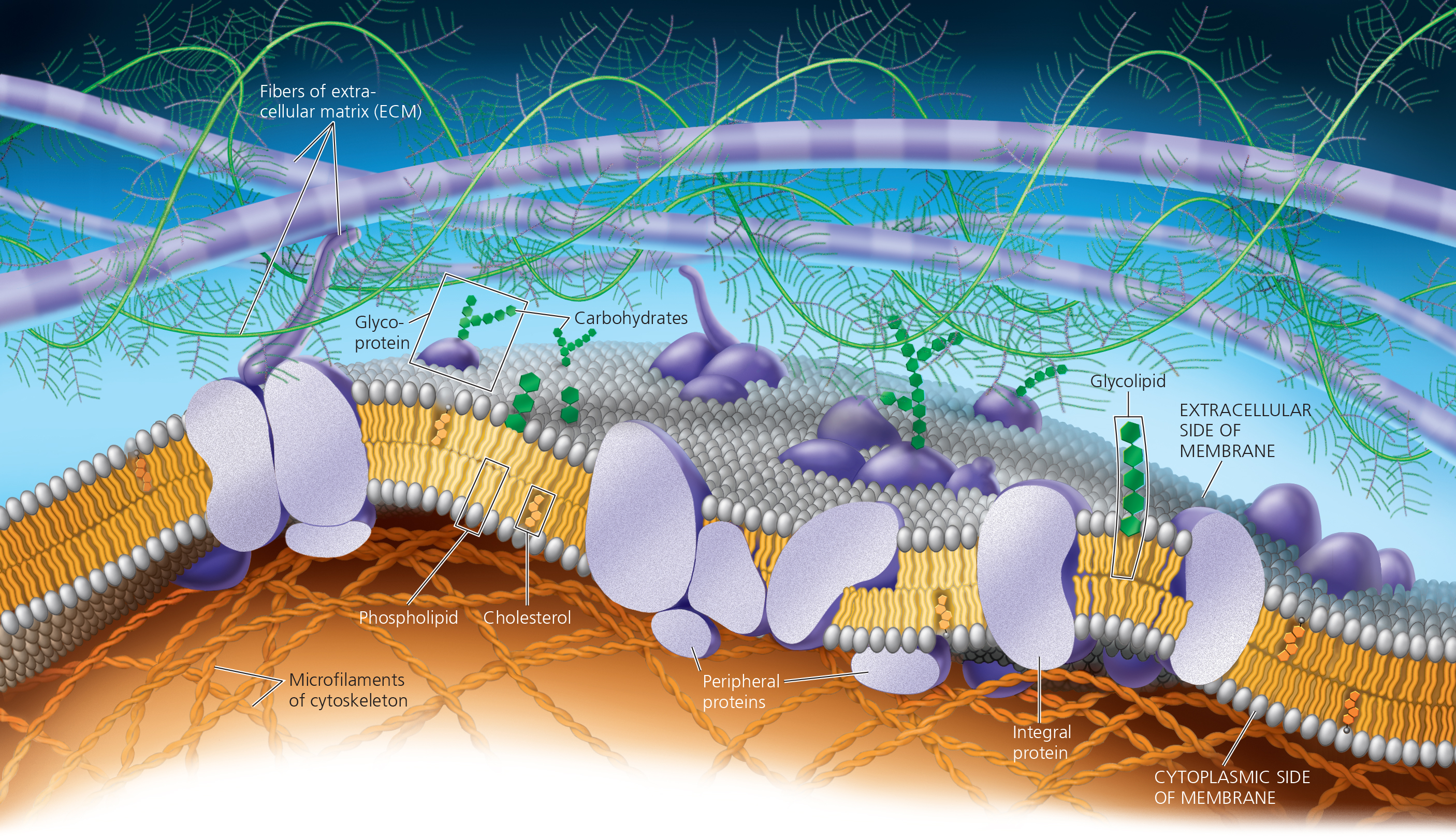
membrane proteins are amphipathic
attached to phospholipid bilayer with hydrophilic regions sticking out
the orientation of this maximizes contact of hydrophilic regions of the protein with water in cytosol and extracellular fluid, while providing hydrophobic parts with nonaqueous environment
fluid mosaic model: membrane is a mosaic of protein molecules bobbing in a fluid bilayer of phospholipids
describes the cell membrane as a tapestry of several types of molecules (phospholipids, cholesterols, and proteins) that are constantly moving
membrane could be more packed with proteins
membrane is held together primarily by hydrophobic interactions (weaker than covalent bonds)
most lipids and some proteins can shift sideways → plane to the membrane
sideways movement is fast
proteins are bigger than lipids so they move slower when they do
many protein seem to be held immobile (not able to move) because of attachment to cytoskeleton or extracellular matrix ECM
some move in a highly directed manner → maybe because driven along cytoskeletal fibers by motor proteins
some drift in membrane
membrane remains fluid as temperature decrease until phospholipid are closley packed and membrane solidifies
temperature when membrane solidifies depend on type of lipid made of
as temperature decreases, membrane remains fluid to lower temp if rich in phospholipids with unsaturated hydrocarbon tails
unsaturated hydrocarbon tails have kinks bc of double bonds
because of where it is located, unsaturated hydrocarbon tails can not pack together as closely as saturated hydrocarbon tails → this looseness makes membrane more fluid
reason why unsaturated fat (ex. olive and canola oil--healthty) are liquidy and saturated fat (ex. butter and cheese--unhealthy) solid
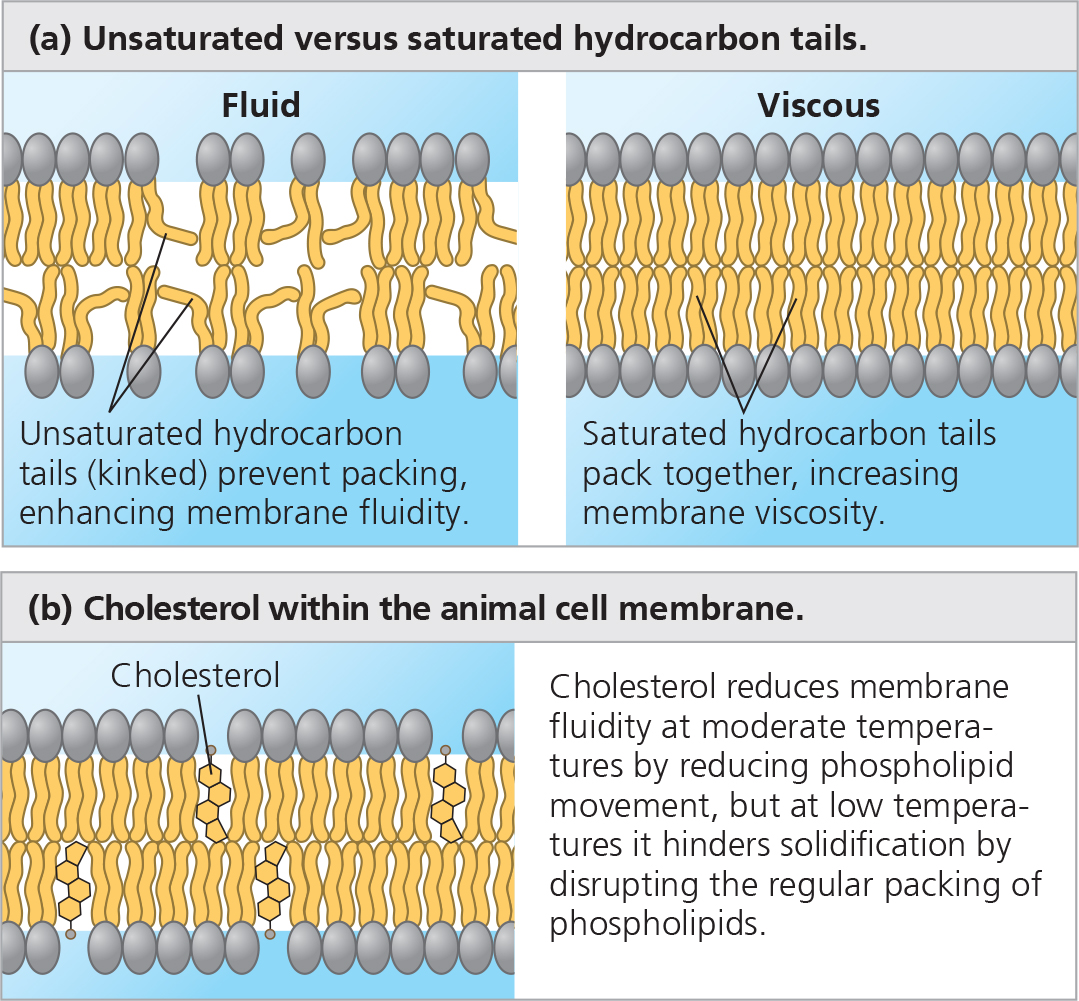
steroid cholesterol (in between phospholipid molecules in plasma membrane of animal cells) has different effects on membrane fluidity at different temperatures
at high temperature (like 98° human body) cholesterol makes membrane less fluid by restraining phospholipid movement
because cholesterol interferes with the close packing of phospholipids, it lowers the required temperature for membrane to solidify
cholesterol helps membrane resist change in fluidity when temperature changes
plants have lower levels of cholesterol so related steroid lipids resist fluidity changes in plant cells
membranes must be fluid to function properly → fluid like olive oil
when solidifies, its permability changes → enzymatic proteins in membrane may become inactive
membrane too fluid cannot support protein function either
extreme environment challenges life → resulting in evolutionary adaptations that include differences in membrane lipid composition
lipid composition variations appear to be evolutionary adaptations that maintain appropriate membrane fluidity under specific environmental conditions
ability to change lipid composition depends on change in temperature → this evolves with organisms where temperature vary
natural selections favor organisms whose mix of membrane lipids ensure an appropriate level of membrane fluidity for environment
a membrane is a collage of different proteins embedded in the fluid matrix of the lipid bilayer
phospholipids are the main fabric of the membrane, but proteins determine membrane’s function
different types of cell has different sets of membrane proteins
two major populations of membrane proteins:
integral proteins
penetrate hydrophobic interior of bilayer
majority: transmembrane proteins (type of integral protein)
span (meaning reach down to bottom/inner of cell) membrane
other integral proteins extend only partway into hydrophobic interior
hydrophobic regions of intergral protein consist of one or more stretches of nonpolar amino acids (20-30 amino acids) → coiled in α-helices
the hydrophilic parts are exposed to aqueous solutions on either side of membrane
some proteins have one or more hydrophilic channels that allow passage of hydrophilic substaces
peripheral proteins
not embedded in lipid bilayer at all
loosely bounded to surface of membrane → often exposed parts of integral protein
some membrane proteins are held in place by attachment to cytoskeleton
certain membrane proteins may attach to materials outside the cell (extracellular side)
in an animal cell, the membrane protein may be attached to fibers of the ECM
gives animal cells a stronger framework than plasma membrane itself
transport:
left--a protein that spans the membrane may provide a hydrophilic channel across the membrane (very selective of solute)
right--a type of transport protein that shuttles a substance from one side to the other by changing its shape. some of these proteins hydrolyze ATP as energy source to actively pump substances across membrane
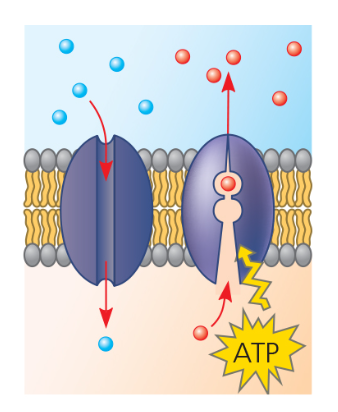
enzymatic activity: a protein built into membrane may be an enzyme with its active site (where reactant binds) exposed to substances in the adjacent solution
several enzymes in membrane are organized as a team to carry out sequential steps of metabolic pathway
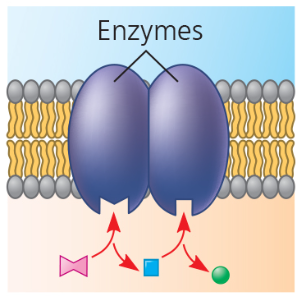
signal transduction: membrane protein (receptor) may have a binding site with specific shape that fits the shape of a chemical messenger [ex. hormone.] the external messenger (signaling molecule) may cause protein to change shape → allowing it to relay the message to the inside of the cell, usually by binding to cytoplasmic protein
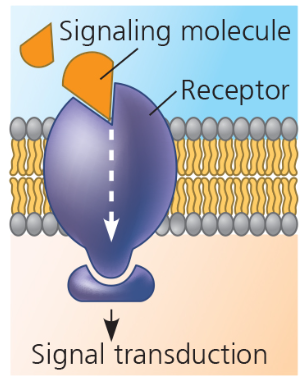
cell-cell recognition: some glycoproteins (made out of carbohydrates) serve as identification tags that are specifically recognized by membrane proteins of other cells.
this type of binding is short-lived
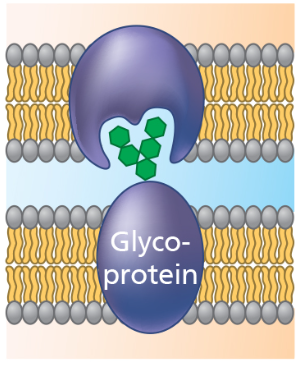
intercellular joining: membrane proteins of adjacent cells may hook together in various kinds of junctions (ex. gap junctions or tight junctions). this type of binding is more long-lasting than cell-cell recognition
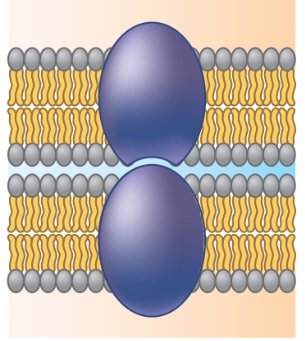
attachment to the cytoskeleton and extracellular matrix (ECM): microfilaments or other elements of cytoskeleton may be noncovalently bound to membrane proteins
function that helps maintain cell shape and stabilizes the location of certain membrane proteins
proteins that can bind to ECM molecules can coordinate extracellular and intracellular changes
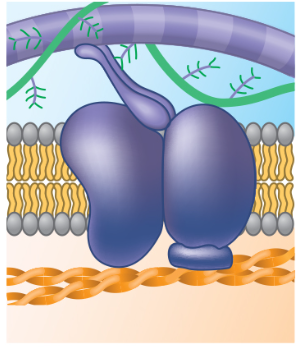
cell-cell recognition (ability to distinguish one type of neighboring cell from another) is important to functioning of an organism
sort cells into tissues and organs in animal embryo
the basis for the rejection of foreign cells by immune system
cells recognize other cells by binding to molecules, often containing carbohydrates--on extracellular surface of plasma membrane
concept 5.2 membrane structure results in selective permeability
small molecules and ions can move across plasma membrane in both directions
sugar, amino acids, and other nutrients enter the cell and metabolic waste leaves the cell. cell takes in O2 for cellular respiration and releases CO2. cell also regulates Na+, K+, Ca2+, and Cl- by shuttling them one or other across plasma membrane
cell membranes are selective in permeability
substances can not across the barrier randomly. it takes up some molecules and ions and excludes others
nonpolar molecues (ex. CO2 and O2) are hydrophobic and so are lipids
can dissolve in lipid bilayer of membrane cross easily w/o help
hydrophobic interior of membrane prevents direct passage through membrane of ions and polar molecules (which are hydrophilic)
polar molecules (ex. glucose and sucrose) pass by slowly through lipid bilayer
water also cross very slowly too
water is a polar molecule (hydrophilic substance)
lipid bilayer is only one aspect of the selective permeability
proteins built in the membrane play key roles in regulating transport
hydrophilic substances can pass plasma membrane and avoiding contact with lipid bilayer by passing through transport proteins
channel proteins: function by having hydrophilic channel that certain molecules or atomic ions to use as a tunnel through membrane
aquaporins: a type of channel protein that specifically facilitates osmosis (diffusion of free water molecules across membrane)
carrier proteins: hold onto their passengers and change their shape in a way that moves them across membrane
transport proteins are specific to which substances can pass through the membrane
ex. a glucose transport protein can move glucose at a faster pace than glucose itself out of the membrane
selective permeability depends on the lipid bilayer and transport protein built into membrane
concept 5.3 passive transport is diffusion of substance across membrane with energy investment
molecules have thermal energy (from constant motion)
diffusion: movement of particles of any substance so that they spread out into available space
molecules move in random motion but diffusion is directional movement

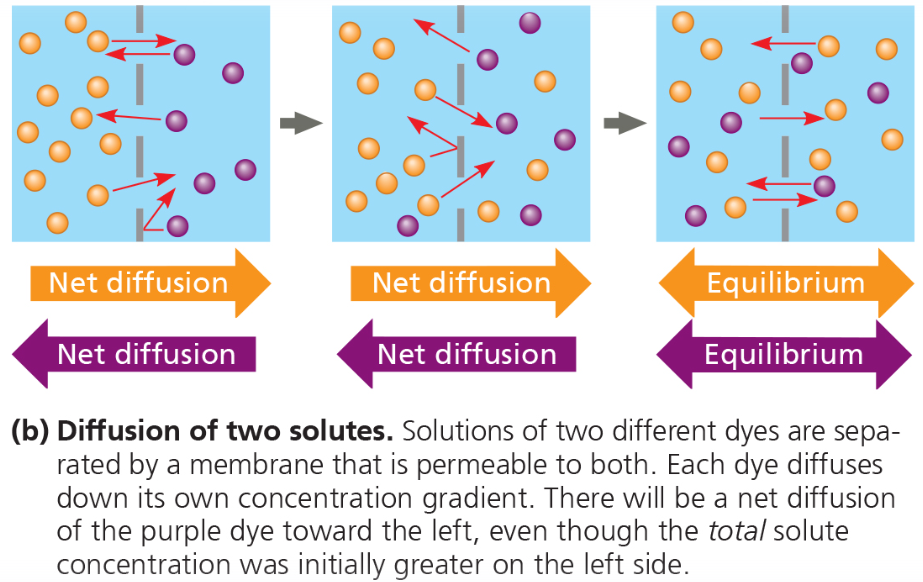
a substance will diffuse from a higher concentration to a lower concentration
it diffuses down its concentration gradient
diffusion is a spontaneous proccess → need no input energy
each substances diffuses down its own concentration gradient, unaffected by the concentration gradient of other substances
most of the traffic across cell membrane occur by diffusion
when a substance is more concentrated on one side of the membrane, a tendency forms to diffuse across (down its concentration gradient)
example: dissolved oxygen diffuses into the cell across the plasma membrane. as long as cellular respiration consumes the O2 as it enters, diffusion will continue because of concentration gradient favors the movement in that direction
passive transport: diffusion of a substance across a biological membrane with no energy
concentration gradient is potential energy itself and drives diffusion
water can diffuse quickly through aquaporins compare to without it
movement of water has important consequences for cell
solution with higher concentration has lower free water molecules
water diffuses across membrane from region of high free water concentration (lower solute concentration) to region of low free water concentration (high solute concentration)
until solute concentrations on both sides are more nearly equal
osmosis: diffusion of free water across selective permeable membrane
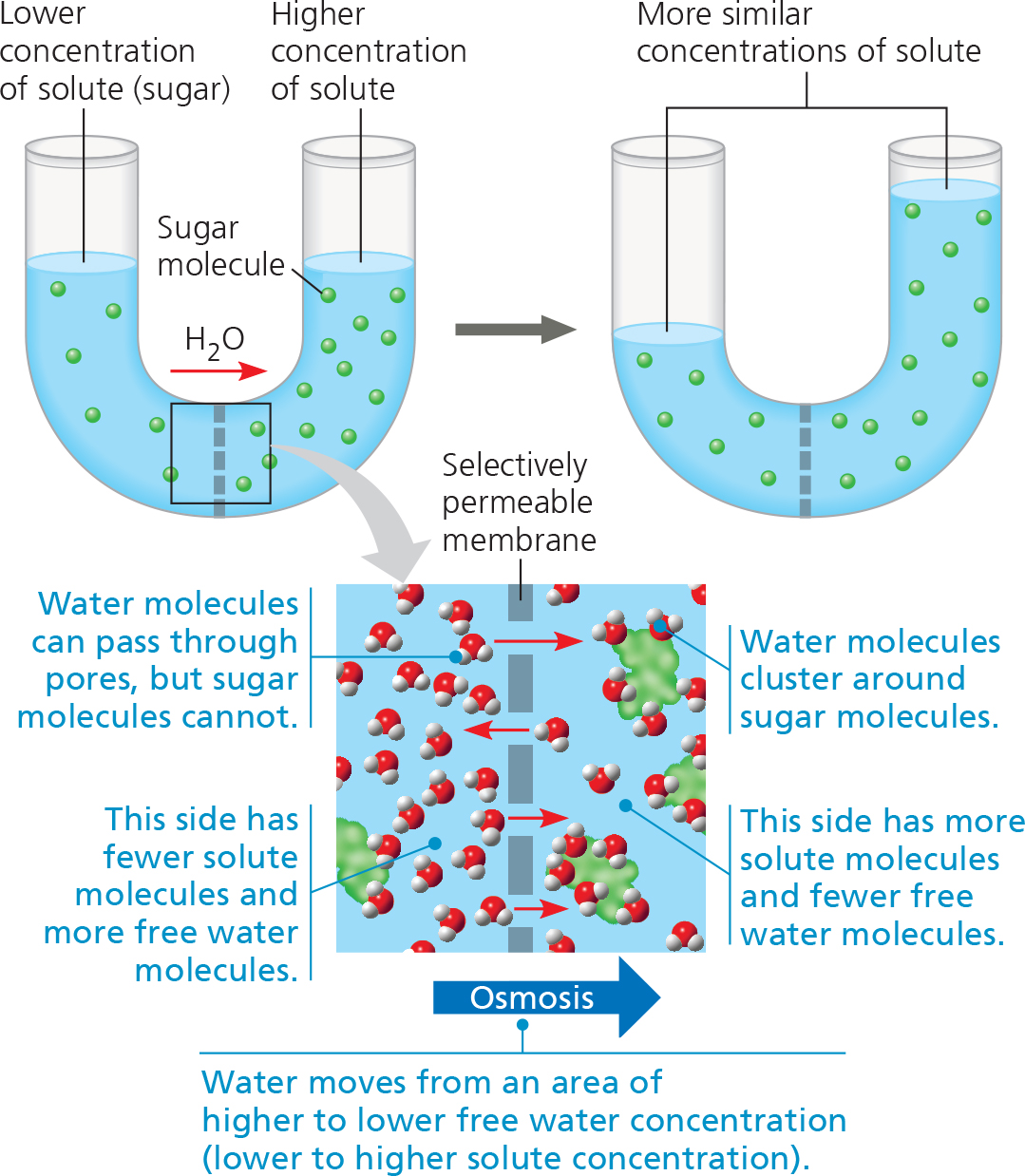
tonicity: the ability of a surrounding solution to cause a cell to gain or lose water
depends on the concentration of solutes that cannot cross the membrane relative to that inside the cell
isotonic: no net movement of water across plasma membrane
hypertonic: shrivels up because not enough water entering cell
reason for increase in saltiness
hypotonic: bursts from too much water entering
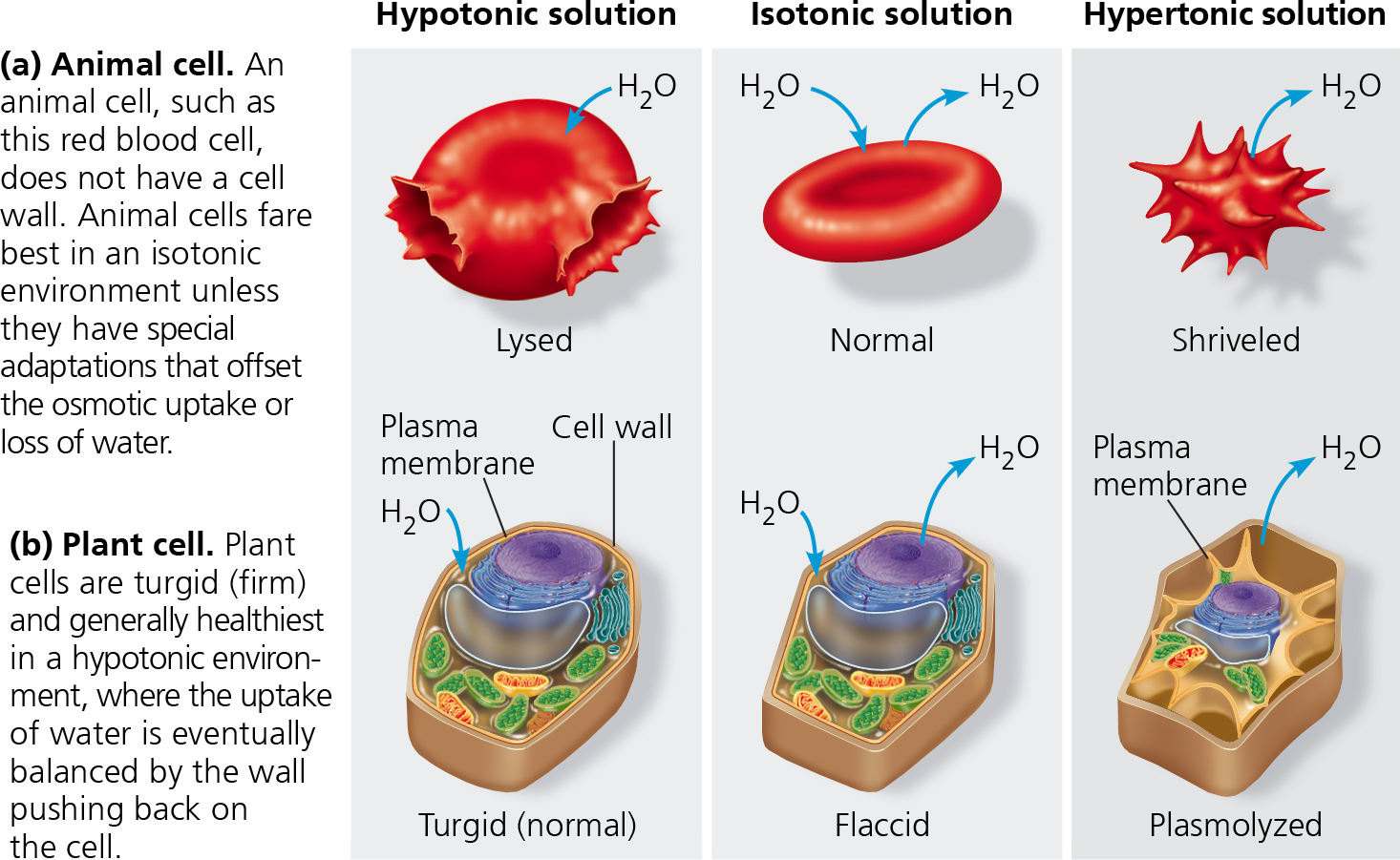
a cell without rigid cells can tolerate neither excessive uptake of water nor excessive loss of water
can be solved if the cell lives in isotonic surroundings
seawater isotonic to many marine animals
organisms that lack rigid cells walls must adapt for osmoregulation (control of solute concentrations and water balance)
the cell of plants, prokaryotes, fungi and other protists
when it is submerged in rainwater, the cell wall helps maintain the cell wall’s balance
plant cell will swell as water enter by osmosis
a cell becomes turgid (very firm) which is a healthy state of cells
if a plant’s cell and surroundings are isotonic, theres no net tendency for water to enter and cells become flaccid (limp); plant will wilt
as a plant cell shrivels, its plasma membrane will pull away from the cell wall
plasmolysis cause plants to wilt and can lead to plant death
facilitated diffusion: many polar and ion molecules impeded by lipid bilayer diffuse passively with help of transport protein that span membrane
concept 5.4 active transport uses energy to move solutes against their gradients
facilitated diffusion considered passive transport because solute is moving down its concentration gradient (process that requires no energy)
speeds transport of a solute by providing efficient passage through membrane but does not alter direction of transport
some other transport proteins can move against their own concentration gradient from side of less concentration to more concentration
Active transport: needs energy to pump solute against their concentration gradient
transport protein that move against their own concentration gradient are all carrier proteins rather than channel proteins
ATP hydrolysis supplies energy for most active transport
one way ATP can power active transport is when the terminal phosphate group is transferred directly to the transport protein
induce the protein to change its shape in a manner that translocate a solute bound to protein acros membrane
ex of this is sodium potassium pump → exchange Na+ for K+ across plasma membrane
all cells have voltages across their plasma membrane
voltage is electrical potential energy
voltage across a membrane is called membrane potential
behaves like a battery → an energy source that affects the traffic of all charged substances across membrane
membrane potential favors passive transport of cations into cell and anions out of cell
2 forces drive diffusion of ions across membrane: chemical force and electrical force
combination called electrochemical gradient
ions diffuses down its electrochemical gradient
usually this in passive transport but also active transport may be neccessary because electrochemical force oppose simple diffusion of an ion down its concentration gradient
electrogenic pump: a transport protein that generates voltage across membrane
main pump of electrogenic pump of plants, fungi, & bacteria is proton pump
cotransport: a transport protein can couple the “downhill” diffusion of the solute to the “uphill” transport of a second substance aginst its own concentration (or electrochemical) gradient
concept 5.5 bulk transport across the plasma membrane occurs by exocytosis and endocytosis
water and small solutes enter and leave the cell by diffusing through the plasma membrane or by being moved across it by transport protein
larger molecules cross membrane in bulk → packaged in vesicles
require energy
cell scretes certain molecues byu fusion of vesicles with plasma membrane → exocytosis
transport vesicle budded from golgi apparatus moves along microtubules of cytoskeleton to plasma membrane
vesicle membrane and plasma membrane fuse when it comes in contact
the lipid molecules from the lipid bilayer rearrange themselves to fuse membranes
as a result, vesicle membrane becomes part of plasma membrane
many cells use exocytosis to export products
ex. pancreas make insulin to secreite it into extracellular fluid by exocytosis.
exocytosis deliver some neccessary proteins and caryboyhydrates from golgi vesciles to outside of the cell to create cell wall
endocytosis: cell takes in molecules and particular matter by forming new vesicles from plasma membrane
endocytosis looks like the reverse of exocytosis to form a pocket
as pocket deepens, it pinches in, forming a vesicle containing material that had been outside cell
3 types of endocytosis: phagocytosis (cellular eating), pinocytosis (cellular drinking), receptor-mediated endocystosis
humans use recepter-mediated endocytosis to take in cholesterol for membrane synthesis and the synthesis of other steroids
endocytosis and exocytosis provide mechanisms for rejuvenating or remodeling plasma membrane
occur continually in most eukaryotic cells
phagocytosis: cell engulfs a particle by extending pseudopodia around it and packaging it within a membranous sac called a food vacuole
will be digested after food vacule fuses with a lysosome containing hydrolytic enzymes
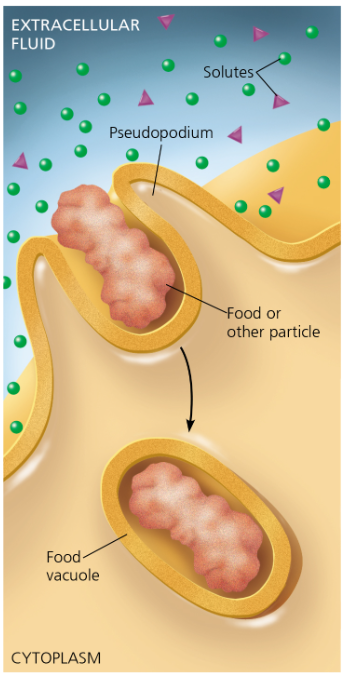
pinocytosis: a cell continually “gulps” droplets of extracellular fluid into tiny vesicles (formed by infoldings of plasma membrane)
cell obtains molecules dissolved in droplets
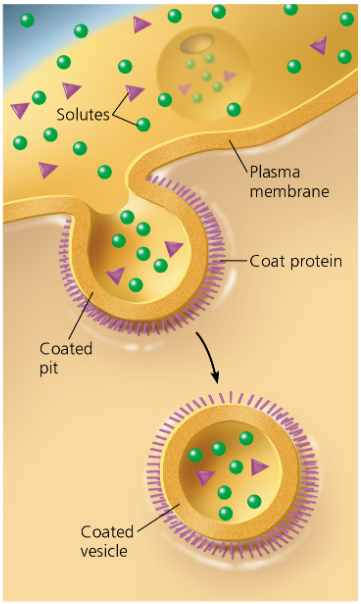
receptor-mediated endocytosis: specialized type of pinocytosis that enables the cell to acquire bulk quantities of specific substances, even tho those substances may not be very concentrated in extracellular fluid
proteins with receptor sites are embedded in plasma membrane are exposed to extracellular fluid
receptor proteins cluster in coated pits and form a vescile containing the bound molecules
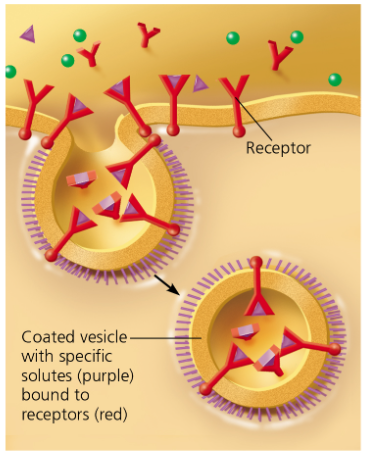
AP bio chapter 5 study note
concept 5.1 cellular membranes are fluid mosaics of lipids and proteins
lipids and proteins are essential to the membranes → carbohydrates too
most abundant lipids are phospholipids
able to form membranes because of their molecular structure
amphipathic (hydrophilic and hydrophobic regions)
a phospholipid bilayer (the actual lipid itself) can be made as a stable boundary between 2 aqueous compartments
the molecular arrangement protects the hydrophobic tail from interacting with the liquid and the hydrophilic head exposed to the water

membrane proteins are amphipathic
attached to phospholipid bilayer with hydrophilic regions sticking out
the orientation of this maximizes contact of hydrophilic regions of the protein with water in cytosol and extracellular fluid, while providing hydrophobic parts with nonaqueous environment
fluid mosaic model: membrane is a mosaic of protein molecules bobbing in a fluid bilayer of phospholipids
describes the cell membrane as a tapestry of several types of molecules (phospholipids, cholesterols, and proteins) that are constantly moving
membrane could be more packed with proteins
membrane is held together primarily by hydrophobic interactions (weaker than covalent bonds)
most lipids and some proteins can shift sideways → plane to the membrane
sideways movement is fast
proteins are bigger than lipids so they move slower when they do
many protein seem to be held immobile (not able to move) because of attachment to cytoskeleton or extracellular matrix ECM
some move in a highly directed manner → maybe because driven along cytoskeletal fibers by motor proteins
some drift in membrane
membrane remains fluid as temperature decrease until phospholipid are closley packed and membrane solidifies
temperature when membrane solidifies depend on type of lipid made of
as temperature decreases, membrane remains fluid to lower temp if rich in phospholipids with unsaturated hydrocarbon tails
unsaturated hydrocarbon tails have kinks bc of double bonds
because of where it is located, unsaturated hydrocarbon tails can not pack together as closely as saturated hydrocarbon tails → this looseness makes membrane more fluid
reason why unsaturated fat (ex. olive and canola oil--healthty) are liquidy and saturated fat (ex. butter and cheese--unhealthy) solid

steroid cholesterol (in between phospholipid molecules in plasma membrane of animal cells) has different effects on membrane fluidity at different temperatures
at high temperature (like 98° human body) cholesterol makes membrane less fluid by restraining phospholipid movement
because cholesterol interferes with the close packing of phospholipids, it lowers the required temperature for membrane to solidify
cholesterol helps membrane resist change in fluidity when temperature changes
plants have lower levels of cholesterol so related steroid lipids resist fluidity changes in plant cells
membranes must be fluid to function properly → fluid like olive oil
when solidifies, its permability changes → enzymatic proteins in membrane may become inactive
membrane too fluid cannot support protein function either
extreme environment challenges life → resulting in evolutionary adaptations that include differences in membrane lipid composition
lipid composition variations appear to be evolutionary adaptations that maintain appropriate membrane fluidity under specific environmental conditions
ability to change lipid composition depends on change in temperature → this evolves with organisms where temperature vary
natural selections favor organisms whose mix of membrane lipids ensure an appropriate level of membrane fluidity for environment
a membrane is a collage of different proteins embedded in the fluid matrix of the lipid bilayer
phospholipids are the main fabric of the membrane, but proteins determine membrane’s function
different types of cell has different sets of membrane proteins
two major populations of membrane proteins:
integral proteins
penetrate hydrophobic interior of bilayer
majority: transmembrane proteins (type of integral protein)
span (meaning reach down to bottom/inner of cell) membrane
other integral proteins extend only partway into hydrophobic interior
hydrophobic regions of intergral protein consist of one or more stretches of nonpolar amino acids (20-30 amino acids) → coiled in α-helices
the hydrophilic parts are exposed to aqueous solutions on either side of membrane
some proteins have one or more hydrophilic channels that allow passage of hydrophilic substaces
peripheral proteins
not embedded in lipid bilayer at all
loosely bounded to surface of membrane → often exposed parts of integral protein
some membrane proteins are held in place by attachment to cytoskeleton
certain membrane proteins may attach to materials outside the cell (extracellular side)
in an animal cell, the membrane protein may be attached to fibers of the ECM
gives animal cells a stronger framework than plasma membrane itself
transport:
left--a protein that spans the membrane may provide a hydrophilic channel across the membrane (very selective of solute)
right--a type of transport protein that shuttles a substance from one side to the other by changing its shape. some of these proteins hydrolyze ATP as energy source to actively pump substances across membrane

enzymatic activity: a protein built into membrane may be an enzyme with its active site (where reactant binds) exposed to substances in the adjacent solution
several enzymes in membrane are organized as a team to carry out sequential steps of metabolic pathway

signal transduction: membrane protein (receptor) may have a binding site with specific shape that fits the shape of a chemical messenger [ex. hormone.] the external messenger (signaling molecule) may cause protein to change shape → allowing it to relay the message to the inside of the cell, usually by binding to cytoplasmic protein

cell-cell recognition: some glycoproteins (made out of carbohydrates) serve as identification tags that are specifically recognized by membrane proteins of other cells.
this type of binding is short-lived

intercellular joining: membrane proteins of adjacent cells may hook together in various kinds of junctions (ex. gap junctions or tight junctions). this type of binding is more long-lasting than cell-cell recognition

attachment to the cytoskeleton and extracellular matrix (ECM): microfilaments or other elements of cytoskeleton may be noncovalently bound to membrane proteins
function that helps maintain cell shape and stabilizes the location of certain membrane proteins
proteins that can bind to ECM molecules can coordinate extracellular and intracellular changes

cell-cell recognition (ability to distinguish one type of neighboring cell from another) is important to functioning of an organism
sort cells into tissues and organs in animal embryo
the basis for the rejection of foreign cells by immune system
cells recognize other cells by binding to molecules, often containing carbohydrates--on extracellular surface of plasma membrane
concept 5.2 membrane structure results in selective permeability
small molecules and ions can move across plasma membrane in both directions
sugar, amino acids, and other nutrients enter the cell and metabolic waste leaves the cell. cell takes in O2 for cellular respiration and releases CO2. cell also regulates Na+, K+, Ca2+, and Cl- by shuttling them one or other across plasma membrane
cell membranes are selective in permeability
substances can not across the barrier randomly. it takes up some molecules and ions and excludes others
nonpolar molecues (ex. CO2 and O2) are hydrophobic and so are lipids
can dissolve in lipid bilayer of membrane cross easily w/o help
hydrophobic interior of membrane prevents direct passage through membrane of ions and polar molecules (which are hydrophilic)
polar molecules (ex. glucose and sucrose) pass by slowly through lipid bilayer
water also cross very slowly too
water is a polar molecule (hydrophilic substance)
lipid bilayer is only one aspect of the selective permeability
proteins built in the membrane play key roles in regulating transport
hydrophilic substances can pass plasma membrane and avoiding contact with lipid bilayer by passing through transport proteins
channel proteins: function by having hydrophilic channel that certain molecules or atomic ions to use as a tunnel through membrane
aquaporins: a type of channel protein that specifically facilitates osmosis (diffusion of free water molecules across membrane)
carrier proteins: hold onto their passengers and change their shape in a way that moves them across membrane
transport proteins are specific to which substances can pass through the membrane
ex. a glucose transport protein can move glucose at a faster pace than glucose itself out of the membrane
selective permeability depends on the lipid bilayer and transport protein built into membrane
concept 5.3 passive transport is diffusion of substance across membrane with energy investment
molecules have thermal energy (from constant motion)
diffusion: movement of particles of any substance so that they spread out into available space
molecules move in random motion but diffusion is directional movement


a substance will diffuse from a higher concentration to a lower concentration
it diffuses down its concentration gradient
diffusion is a spontaneous proccess → need no input energy
each substances diffuses down its own concentration gradient, unaffected by the concentration gradient of other substances
most of the traffic across cell membrane occur by diffusion
when a substance is more concentrated on one side of the membrane, a tendency forms to diffuse across (down its concentration gradient)
example: dissolved oxygen diffuses into the cell across the plasma membrane. as long as cellular respiration consumes the O2 as it enters, diffusion will continue because of concentration gradient favors the movement in that direction
passive transport: diffusion of a substance across a biological membrane with no energy
concentration gradient is potential energy itself and drives diffusion
water can diffuse quickly through aquaporins compare to without it
movement of water has important consequences for cell
solution with higher concentration has lower free water molecules
water diffuses across membrane from region of high free water concentration (lower solute concentration) to region of low free water concentration (high solute concentration)
until solute concentrations on both sides are more nearly equal
osmosis: diffusion of free water across selective permeable membrane

tonicity: the ability of a surrounding solution to cause a cell to gain or lose water
depends on the concentration of solutes that cannot cross the membrane relative to that inside the cell
isotonic: no net movement of water across plasma membrane
hypertonic: shrivels up because not enough water entering cell
reason for increase in saltiness
hypotonic: bursts from too much water entering

a cell without rigid cells can tolerate neither excessive uptake of water nor excessive loss of water
can be solved if the cell lives in isotonic surroundings
seawater isotonic to many marine animals
organisms that lack rigid cells walls must adapt for osmoregulation (control of solute concentrations and water balance)
the cell of plants, prokaryotes, fungi and other protists
when it is submerged in rainwater, the cell wall helps maintain the cell wall’s balance
plant cell will swell as water enter by osmosis
a cell becomes turgid (very firm) which is a healthy state of cells
if a plant’s cell and surroundings are isotonic, theres no net tendency for water to enter and cells become flaccid (limp); plant will wilt
as a plant cell shrivels, its plasma membrane will pull away from the cell wall
plasmolysis cause plants to wilt and can lead to plant death
facilitated diffusion: many polar and ion molecules impeded by lipid bilayer diffuse passively with help of transport protein that span membrane
concept 5.4 active transport uses energy to move solutes against their gradients
facilitated diffusion considered passive transport because solute is moving down its concentration gradient (process that requires no energy)
speeds transport of a solute by providing efficient passage through membrane but does not alter direction of transport
some other transport proteins can move against their own concentration gradient from side of less concentration to more concentration
Active transport: needs energy to pump solute against their concentration gradient
transport protein that move against their own concentration gradient are all carrier proteins rather than channel proteins
ATP hydrolysis supplies energy for most active transport
one way ATP can power active transport is when the terminal phosphate group is transferred directly to the transport protein
induce the protein to change its shape in a manner that translocate a solute bound to protein acros membrane
ex of this is sodium potassium pump → exchange Na+ for K+ across plasma membrane
all cells have voltages across their plasma membrane
voltage is electrical potential energy
voltage across a membrane is called membrane potential
behaves like a battery → an energy source that affects the traffic of all charged substances across membrane
membrane potential favors passive transport of cations into cell and anions out of cell
2 forces drive diffusion of ions across membrane: chemical force and electrical force
combination called electrochemical gradient
ions diffuses down its electrochemical gradient
usually this in passive transport but also active transport may be neccessary because electrochemical force oppose simple diffusion of an ion down its concentration gradient
electrogenic pump: a transport protein that generates voltage across membrane
main pump of electrogenic pump of plants, fungi, & bacteria is proton pump
cotransport: a transport protein can couple the “downhill” diffusion of the solute to the “uphill” transport of a second substance aginst its own concentration (or electrochemical) gradient
concept 5.5 bulk transport across the plasma membrane occurs by exocytosis and endocytosis
water and small solutes enter and leave the cell by diffusing through the plasma membrane or by being moved across it by transport protein
larger molecules cross membrane in bulk → packaged in vesicles
require energy
cell scretes certain molecues byu fusion of vesicles with plasma membrane → exocytosis
transport vesicle budded from golgi apparatus moves along microtubules of cytoskeleton to plasma membrane
vesicle membrane and plasma membrane fuse when it comes in contact
the lipid molecules from the lipid bilayer rearrange themselves to fuse membranes
as a result, vesicle membrane becomes part of plasma membrane
many cells use exocytosis to export products
ex. pancreas make insulin to secreite it into extracellular fluid by exocytosis.
exocytosis deliver some neccessary proteins and caryboyhydrates from golgi vesciles to outside of the cell to create cell wall
endocytosis: cell takes in molecules and particular matter by forming new vesicles from plasma membrane
endocytosis looks like the reverse of exocytosis to form a pocket
as pocket deepens, it pinches in, forming a vesicle containing material that had been outside cell
3 types of endocytosis: phagocytosis (cellular eating), pinocytosis (cellular drinking), receptor-mediated endocystosis
humans use recepter-mediated endocytosis to take in cholesterol for membrane synthesis and the synthesis of other steroids
endocytosis and exocytosis provide mechanisms for rejuvenating or remodeling plasma membrane
occur continually in most eukaryotic cells
phagocytosis: cell engulfs a particle by extending pseudopodia around it and packaging it within a membranous sac called a food vacuole
will be digested after food vacule fuses with a lysosome containing hydrolytic enzymes

pinocytosis: a cell continually “gulps” droplets of extracellular fluid into tiny vesicles (formed by infoldings of plasma membrane)
cell obtains molecules dissolved in droplets

receptor-mediated endocytosis: specialized type of pinocytosis that enables the cell to acquire bulk quantities of specific substances, even tho those substances may not be very concentrated in extracellular fluid
proteins with receptor sites are embedded in plasma membrane are exposed to extracellular fluid
receptor proteins cluster in coated pits and form a vescile containing the bound molecules

 Knowt
Knowt